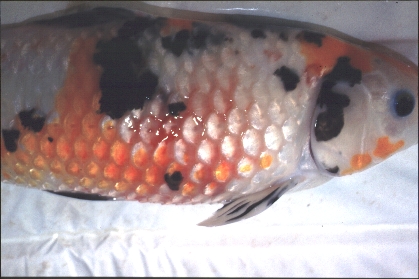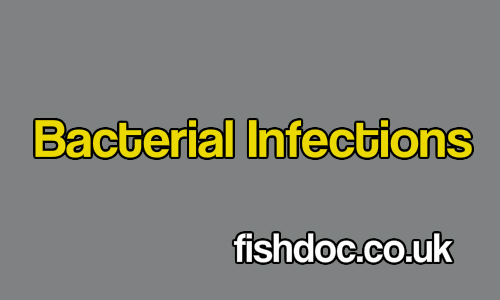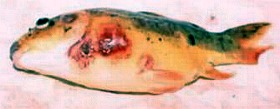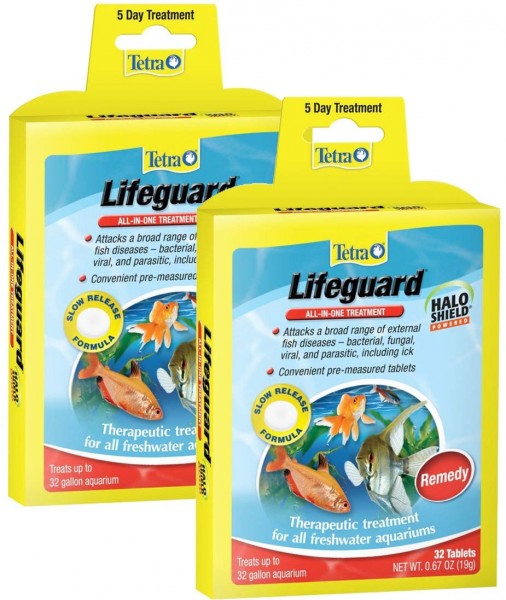Bacterial infections and diseases
Common and difficult problems to deal with
Bacterial fish diseases
Bacterial fish diseases and infections are very common in fish keeping and are probably one of the hardest health problems to deal with effectively. However, with a basic understanding of how bacteria cause disease and how to recognize bacterial infections it is possible to deal successfully with the majority of problems. The key to successful treatment of bacterial disease is early, accurate diagnosis and treatment. If treatment is delayed it can lead to substantial losses. This is particularly relevant to koi ponds, which, for a variety of reasons, are often susceptible to outbreaks of bacterial disease.
Bacterial Infection |
|
|
|
A typical bacterial infection with a large area of ulceration just behind the operculum (gill cover). The whole of the pectoral fin has been totally eroded. Both the pelvic fins and anal fin are very red and inflamed. The caudal (tail) fin has advanced fin rot The fish survived with a combination of antibiotic injections and topical treatments. photo: Frank Prince-Iles |
Pathogenic bacteria can spread disease throughout the fish’s body if they are absorbed through the gills or gut, or gain entry via the skin. This is known as a systemic infection. Other bacterial infections cause localised surface disease such as fin rot and ulcers, however, if these are not resolved they can lead to a systemic infection. In general there are four types of bacterial infections that the hobbyist needs to be aware of:
- Fin rot – usually resulting from environmental stress
- Bacterial body ulcers – open, shallow to deep, lesions on the fish’s body
- Bacterial gill disease – in which the gills are the primary target
- Systemic bacterial disease – in which bacteria invade the fish’s body and damage internal organs.
Diagnosing bacterial infections
Exhibiting my normal caution about “instant” diagnosis let me say that a definite diagnosis of bacterial fish disease requires sampling and culture of bacteria from the lesion or organ. The problem is that many clinical signs of bacterial disease could also be caused by other problems such as viruses, poor water quality or parasites and we need to be aware of the dangers of jumping to conclusions. However, taking these qualifications into account, typical (external) signs of bacterial disease are;
- Red and inflamed areas on the body and fins, raised scales, skin ulcers, exophtalmos (pop-eye), dropsy or swollen abdomen, fin rot. Additionally, affected fish may be lethargic and anorexic
- Internally there may be lesions or haemorrhages in internal organs and/or a build-up of often bloody fluid in the abdomen (ascites).
Any of these signs warrant immediate further investigation.
Bacterial infections |
|
 Koi carp with bacterial infection. There are raised scales, with extensive inflammation and swelling. If left untreated the infected area is liable to ulcerate Koi carp with bacterial infection. There are raised scales, with extensive inflammation and swelling. If left untreated the infected area is liable to ulcerate |
|
 Bacterial infection in testis of a koi carp. There were no external signs of disease Bacterial infection in testis of a koi carp. There were no external signs of disease |
|
|
photos: Frank Prince-Iles |
|
Where do bacterial infections come from?
It is important to our understanding of bacterial disease to realise that there are essentially two types of pathogenic (disease-causing) bacteria
- Primary or obligate pathogens – These are pathogens that are not part of the normal aquatic flora and are capable of causing disease in healthy individuals. Typically, Aeromonas salmonicida
- Opportunistic pathogens. These are normally free-living, either in the water on the fish, but are capable of adopting a pathogenic role under certain circumstances. Many of these are saprophytes, normally living on dead organic matter such as plant and animal remains or faeces. Typically, Aeromonas hydrophilia, Pseudomonas and Vibrio. In organically-rich water there may be millions of these opportunistic bacteria in every litre of water, but under normal circumstances, they do not pose a threat to healthy fish. This situation can be directly compared to the normal microbial flora of the human mouth and skin which are teeming with potentially harmful ‘germs’ but rarely cause any problems unless the bugs can get past our body defences.
As you might have guessed, in general most of the bacterial diseases that affect ornamental fish are caused by opportunistic bacteria. Which means that most bacterial infections result because of changes in the bacteria / fish relationship. This is a very delicate relationship, but generally when an opportunistic bacterium tries to establish an infection the fish host is able to resist by a variety of defence mechanisms. However, if the numbers or virulence of the pathogen increases or the host resistance is reduced the pathogen may be able to succeed
 |
|
Host / parasite relationship: The balance between susceptibility and resistance determines either good health or disease |
How do opportunistic bacteria become pathogenic?
I should stress that we are taking a somewhat over-simplified view of a complex subject, but in general there seems to be three major ways that infections occur
- Damage to the integument (skin) resulting from an abrasion, parasite activity or chemical damage (for example from ammonia, nitrite or high/low pH). My own experience is that small cuts or abrasions on healthy fish rarely become infected – in much the same way that we do not get infections every time we cut ourselves. I mention this because there is often a tendency to diagnose obvious bacterial infections as “cuts” or scrapes and hope they get better.
- The fish’s normal defences are depressed as a result of environmental stress or disease. This enables opportunistic bacteria to take advantage. This is similar to the situation when we catch colds and other diseases if we are run-down. Fish can become stressed for a variety of reasons, the most common reasons being poor water quality, parasites, overcrowding, thermal stress.
- A substantial increase in the numbers of opportunistic bacteria such as we would find in systems with other infected fish and /or high levels of decomposing organic matter. This is typically the situation when the disease starts to spread and several fish are affected. Under these conditions, especially if fish are still stressed, it seems that some opportunistic bacteria can become primary pathogens through weight of numbers.
It is because of these complications, together with tremendous reproductive potential of most bacteria, that a seemingly minor problem can rapidly snowball out of control leading to high numbers of infected fish and possibly many losses.
Treating bacterial infections
It is hard to lay down hard and fast rules about treating bacterial diseases. It mostly comes down to the experience of the person on the spot in deciding how severe the situation is and what course of action is required. However, before any treatment is started it is important to try and establish the underlying cause – particularly if several fish are affected, as this would suggest some form of environmental stress.
The reason why this is important is that few, if any, treatments completely destroy all the pathogenic bacteria. What they do is knock the bacteria back for a short time, giving the fish’s own defenses chance to start fighting back and the wound-healing process chance to start.
Clearly, the fish will only be able to fight back if conditions are improved and all efforts are made to keep the numbers of bacteria as low as possible. So really any anti-bacterial treatments should be seen as supportive treatment for the fish’s own immune system and what we are trying to do is to tilt the balance of health back in the fish’s favour.
There are broadly four treatment methods for bacterial infections. They can be used individually or in combination for an enhanced effect
Baths:
- Short-term baths for a few hours each day using anti-bacterial products such as chloramine-T, potassium permanganate or antibiotics
- Long-term pond or tank treatments usually using a proprietary anti-bacterial or anti-ulcer product
- Tetra’s Lifeguard product is a halamine antimicrobial on par with Chloramine T. (Discussion of Lifeguard)
On their own baths are only likely to be effective for relatively minor bacterial infections such as fin rot or situations when just one or two fish have minor ulcerations. This supposes that any underlying problems are resolved or treated. Baths are unlikely to resolved severe cases.
Topical treatments:
This involves cleaning the lesion, usually with an antiseptic solution and applying a waterproof ointment or cream such as Orabase or similar. Topical treatments, if used properly can be very effective in dealing with minor to moderate cases – providing that the infection is not systemic. I would normally expect to see signs of improvement – that is a reduction in inflammation or the first visible signs of skin growth – within seven days of the start of treatment. If there is no sign of healing within a week to ten days a change of treatment is vital.
Medicated food
These are specially prepared foods containing antibiotics. In the UK they are only available with a veterinary prescription. While the use of medicated food has obvious advantages, the disadvantages are the slight delay while the food is ordered and processed, very sick fish may not be eating and there is widespread resistance to the most commonly used antibiotics. It is possible to prepare your own medicated food by top-dressing ordinary food with an appropriate antibiotic.
Antibiotics (injectable)
This usually involves a course of five injections over a ten-day period in conjunction with topical treatments. It is important to use the appropriate antibiotic (established by laboratory antibiotic sensitivity tests). This procedure does require a degree of knowledge and skill. As it usually involves sedating the fish for every treatment it can be very time-consuming, particularly if large numbers of fish are involved. The positive side is that there is a very high success rate (typically > 90%)– even in the most severe cases.



